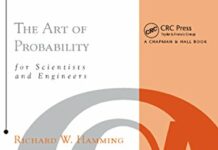
Ebook Info
- Published: 2020
- Number of pages: 432 pages
- Format: PDF
- File Size: 3.03 MB
- Authors: Richard W. Hamming
Description
A groundbreaking treatise by one of the great mathematicians of our age, who outlines a style of thinking by which great ideas are conceived.What inspires and spurs on a great idea? Can we train ourselves to think in a way that will enable world-changing understandings and insights to emerge?Richard Hamming said we can. He first inspired a generation of engineers, scientists, and researchers in 1986 with “You and Your Research,” an electrifying sermon on why some scientists do great work, why most don’t, why he did, and why you can—and should—too. The Art of Doing Science and Engineering is the full expression of what “You and Your Research” outlined. It’s a book about thinking; more specifically, a style of thinking by which great ideas are conceived.The book is filled with stories of great people performing mighty deeds—but they are not meant simply to be admired. Instead, they are to be aspired to, learned from, and surpassed. Hamming consistently returns to Shannon’s information theory, Einstein’s theory of relativity, Grace Hopper’s work on high-level programming, Kaiser’s work on digital fillers, and his own work on error-correcting codes. He also recounts a number of his spectacular failures as clear examples of what to avoid.Originally published in 1996 and adapted from a course that Hamming taught at the US Naval Postgraduate School, this edition includes an all-new foreword by designer, engineer, and founder of Dynamicland Bret Victor, plus more than 70 redrawn graphs and charts.The Art of Doing Science and Engineering is a reminder that a capacity for learning and creativity are accessible to everyone. Hamming was as much a teacher as a scientist, and having spent a lifetime forming and confirming a theory of great people and great ideas, he prepares the next generation for even greater distinction.
User’s Reviews
Editorial Reviews: Review “Your last chance to read the words of thinking of one of the major intellects that the USA has produced.”—Eugene N. Miya, NASA researcher”Hamming is here to tell you about excellence. His lessons unfold through personal stories of discovery and failure—life as an extraordinary scientist. But Hamming demands that you do extraordinary work, too, and for that he offers the best advice I know.”—Andy Matuschak, software engineer, designer, and researcher”Hamming was always as much a teacher as a scientist, and having spent a lifetime forming and confirming a theory of great people, he felt he could prepare the next generation for even greater greatness. That’s the premise and promise of this book.”—Bret Victor, founder of Dynamicland, designer, and engineer About the Author Richard W. Hamming (1915–1998) was a scientist and mathematician whose work inspired a generation of engineers, scientists, and researchers. He is best known for discovering mathematical formulas that allow computers to correct their own errors, a fundamental function of modems, compact disks, and satellite communications. Born in Chicago in 1915, he provided crucial programming support as a member of the Manhattan Project. After World War II, he joined Bell Labs, where over the next 15 years he was involved in nearly all of its most prominent achievements. He later taught and lectured at the Naval Postgraduate School in Monterey, California. Throughout his career, Hamming received many awards for his work, including the Turing Award in 1968, the highest honor in computer science. In 1988, the Institute of Electrical and Electronics Engineers created the Richard W. Hamming Medal in his honor, of which he was the first recipient. Chicago, IL
Reviews from Amazon users which were colected at the time this book was published on the website:
⭐I’m halfway tempted to write my engineering college and demand a full refund considering this book wasn’t required reading. This is a must have for anyone in an engineering field(or any STEM field for that matter). The book is written so well. Hamming somewhat apologizes for the first person references in the intro, I would argue this is the best part. His anecdotes about how he learned a particular lesson were not only engaging to read, but clearly defined the message. It almost felt like I was having coffee with this guy and he was telling old war stories. Seriously one of the most unique science books I’ve ever read.The more technical chapters on error coding and filters were the real reason I purchased the book, as I had been doing some ECC implementations and was looking to really see how this was “discovered”. These chapters (while brillant) were actually not the parts I enjoyed the most. The chapters on simulation actually had me screaming “YES!” when he describes reliance on simulation as a mistake, and that simulation only closely approximates reality. His insistence that while fast simulations are great, time between the simulations can be just as important, and that a true scientist should be thinking about the results before the results are calculated. These thought simulations allow the scientist/engineer to start thinking about the problem and what the simulation doesn’t account for. It was quite refreshing to hear this.Ever since reading this book, I’ve started purchasing a copy for anyone who works under me. Understanding the math behind the problems isn’t required. It’s nice, to understand it, but certainly not the value you should receive out of this.Again, I honestly am floored that this wasn’t required reading where I attended college. It’s possible that someone in college would not be able to appreciate it, but after being in my career for 8 years, it is truly the most interesting and engaging STEM book I have read.
⭐While the book was written in 1994 and makes predictions about what computer science might look like in 2020, that isn’t the point of the book. This is a great work by someone who got into the computing game in the 1940’s right when things were starting to take off. The author’s name should be familiar to you (aka the Hamming code) which adds a nice cachet of credibility.Hamming takes you through a fun history of computers and the art of computer programming but also with a larger point: trying to get you to think great thoughts. There are lots of wonderful insights in this book about management, corporate culture, scientific style and thinking about the future. The book is a beautifully made hardback priced like a softback — a terrific value, and a thought provoking and inspiring read.
⭐This book is perfectly written like a college lecture, and even describes itself as so.Like any good college lecture, there’s an adequate amount of rambling and anecdotes, interspersed with sporadic great ideas for those able to muster energy to stagger forward and stay awake. This has made it a difficult work to struggle through as a book to read before bedtime. It really brought me back to the physics classes of my college days, praying the professor could locate and make a point in any thirty minute stretch and then painfully trying to understand the connections of stray thoughts to the equations which seemed to come out of thin air.I was hoping for something more cohesive, but Hamming’s undoubtable brilliance makes this an interesting read for those willing to cope with the style. Be ready for fascinating stories about computing history, predictions for the future, and different ways of thinking about things from a great mind.
⭐I came by Richard Hamming via a footnote on an essay on learning what it takes to become better at handling information. With my curiosity piqued, I decided to purchase this new edition, and I’m glad I did.I’m nearly two-thirds through it, and I’ve already jotted down several notes on passages where Professor Hamming goes into detail on communicating ideas better, coding, learning, and mathematics. His chapter on Claude Shannon’s Information (Communication) Theory is worth the price of the book alone.I realise this book is not groundbreaking, but I’ve enjoyed his thought process as it differs from many similar books where it leaves me to reflect on things I was taking for granted in my thinking. And any book that’s a cause for reflection on one’s thoughts is a worthy exercise if it means overall better progress for oneself.
⭐Very interesting and even though it is from the 90’s the main topic is still relevant. A well thought well explained book. Not for everyone, but will recommend it to creatives and divergent thinkers.
⭐it has many good examples of problems and examples.It did no have enough of the items and methods I was most interested in.
⭐He’s done it, and thought about how he and people around him have behaved and what their “style” is. Now he wants you to do it.
⭐TediousBoringOver explainedI seriously doubt if any value to be gained from this in 2021Three more words
Keywords
Free Download The Art of Doing Science and Engineering: Learning to Learn in PDF format
The Art of Doing Science and Engineering: Learning to Learn PDF Free Download
Download The Art of Doing Science and Engineering: Learning to Learn 2020 PDF Free
The Art of Doing Science and Engineering: Learning to Learn 2020 PDF Free Download
Download The Art of Doing Science and Engineering: Learning to Learn PDF
Free Download Ebook The Art of Doing Science and Engineering: Learning to Learn




